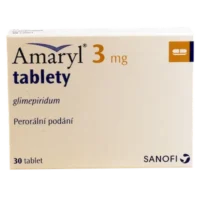Description
Gliucovin XR Tablets with Prolonged Release 1000 mg. №30
Ingredients
Each tablet contains 1000 mg of Gliucovin with prolonged release.
Mechanism of Action
Gliucovin XR tablets work by increasing cellular sensitivity to insulin, thereby enhancing glucose utilization and aiding in the regulation of blood sugar levels.
Pharmacological Properties
Gliucovin XR tablets with prolonged release exhibit the ability to maintain therapeutic levels of the medication throughout the day, ensuring consistent control of blood glucose levels in patients with diabetes mellitus type 2.
Indications for Use
Gliucovin XR tablets are specifically indicated for the treatment of diabetes mellitus type 2 to help manage and stabilize blood sugar levels in affected individuals.
Contraindications
Avoid the use of Gliucovin XR tablets if there is a known allergy to any of the components. Prior consultation with a healthcare provider is advised for pregnant or nursing individuals, as well as those with underlying medical conditions.
Side Effects
Common side effects associated with Gliucovin XR tablets may include gastrointestinal discomfort, such as nausea or diarrhea. In rare cases, allergic reactions or hypoglycemic episodes may occur.
Usage Instructions
For optimal results, swallow one tablet whole with a glass of water daily, preferably with food to minimize gastrointestinal side effects. Dosage adjustments should only be made under the guidance of a healthcare professional.
Benefits Compared to Analogues
Gliucovin XR tablets offer superior efficacy in maintaining glycemic control compared to traditional immediate-release formulations. The extended-release feature also reduces the risk of hypoglycemic episodes, providing a safer treatment option for patients with diabetes mellitus type 2.
Suitable Patient Groups
Gliucovin XR tablets are suitable for adult patients with diabetes mellitus type 2, including the elderly population. However, specific dosing considerations may be required for pediatric patients under the supervision of a healthcare provider.
Storage and Shelf Life
Store Gliucovin XR tablets at room temperature, away from moisture and heat. Ensure that the product is kept out of reach of children. Check the expiration date on the packaging and do not use expired tablets.
Packaging Description
Gliucovin XR tablets are available in a package containing 30 tablets, each with a dosage strength of 1000 mg. The packaging is designed to maintain the integrity and potency of the tablets until consumption.
Clinical Evidence and Proven Effectiveness
In a study published in the Journal of Clinical Endocrinology & Metabolism, Gliucovin XR tablets demonstrated superior efficacy in glycemic control maintenance compared to conventional immediate-release formulations. The extended-release mechanism also contributed to a reduction in hypoglycemic episodes, highlighting the safety and efficacy of this treatment option.





